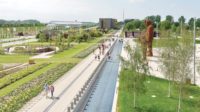You can open Sweet & Salt to a photo of torrential water ripping through the streets of a medieval town or a golden-hued painting of a peaceful ice-covered pond just after the chilly sun has set. Is this a history, a guidebook, a cautionary tale of climate change, a dike-designer’s handbook, or an art book? In the hands of Tracy Metz, a long-time contributor to Architectural Record, and art historian Maartje van den Heuvel, it is all of the above.
Sweet & Salt: Water and the Dutch, by Tracy Metz and Maartje van den Heuvel. Rotterdam: NAi publishers, 2012, distributed in the U.S. by D.A.P), 296 pages, $45.
Sweet & Salt is an intensely heavily visual consideration of the history, culture, and engineering of water that engages our senses and our emotions—not just our intellect—with its ravishing (and beautifully printed) photography, cartography, and art. We’re awed and enraptured by water—when we’re not fighting it off.
You will not find any hand-wringing in this volume. Sweet & Salt is a profoundly humanistic consideration of the culture of water, with, along the way, many ideas by designers about how to deal with water’s myriad challenges. Architects, planners, and landscape designers will never think of a riverbank, levee, or seashore the same way again.
The not-so-underlying theme is of the Dutch as canaries in the global-warming coal mine. Much of Holland’s most productive land is below sea level, so the Dutch are acutely aware of subtle changes in the rivers, seas, and weather that get lost in the climactic background noise in America. After all, the nation has built its culture, government, social arrangements, and urban planning around water for hundreds of years.
Even for this enormously competent nation, the challenges that climate change brings are daunting. Droughts dry up rivers even in such a characteristically damp country. Floods threaten the world’s most elaborately contrived system of levees, canals, locks, and barriers. Sea-level rise may be barely detectable, but salt water infiltrating fresh groundwater is already becoming a major problem for Dutch farmers.
A companion volume to an exhibition at the Kunsthal in Amsterdam, the book wraps a myriad of ideas, politics, history, and art around five big themes: Conflict, Concord, Profit, Pleasure, and Myth. If these categories are grand and unwieldy, they also make the book an enormous pleasure. You detect some repetition. You get lost among luscious and provocative paintings and photos. Put away the hair shirt, please, and enjoy.
James S. Russell is the architecture critic for Bloomberg News. His book The Agile City: Building Wealth and Well Being in an Era of Climate Change was recently issued in paperback and Kindle editions.






Post a comment to this article
Report Abusive Comment